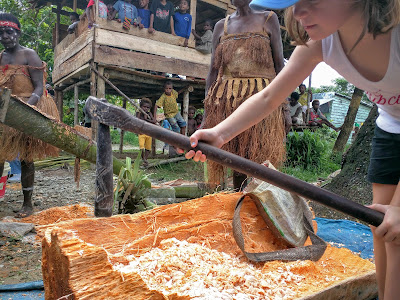 Our school went to visit one of the local Kamoro tribes last week. If you have read or seen Guns, Germs, and Steel by Jared Diamond, you may be familiar with the tribes in Papua, New Guinea that he interacted with and based his theories of the roots of inequality upon. We met with the distant cousins of those tribes here in West Papua, with the help of a man named Kal Muller. Like Diamond, Muller has lived with and studied the tribes here for decades. He has done much to educate people about the Kamoro way of life and the challenges the people face due to encroachment on their territory.
Our school went to visit one of the local Kamoro tribes last week. If you have read or seen Guns, Germs, and Steel by Jared Diamond, you may be familiar with the tribes in Papua, New Guinea that he interacted with and based his theories of the roots of inequality upon. We met with the distant cousins of those tribes here in West Papua, with the help of a man named Kal Muller. Like Diamond, Muller has lived with and studied the tribes here for decades. He has done much to educate people about the Kamoro way of life and the challenges the people face due to encroachment on their territory. Diamond shares an anecdote about a tribal man asking him, thirty year ago, why the white men have so much 'cargo'. Fair question. When foreigners first came here, the fact they had so much sophisticated cargo gave them a sense of power and supremacy over the tribes. Diamond explains his theory of geographic luck--how some civilizations have thrived simply because they were born into a place that enabled them to do so. He maintains that racial supremacy has nothing to do with it and that the tribes have had to use tremendous ingenuity to overcome great challenges to survive here in this jungle. Diamond asserts that he could never survive the jungle without the help of the tribes and after spending a day watching them work--I have to agree.
 |
| Niamh using an adze to pound the Sago. |
 |
| Tequila chaser needed |
 |
| The log where the Tambelo treats are found |

Not only did the tribe show us how they make their food, they also demonstrated how they weave and carve. There was a lot to see and it was incredibly hot and muggy and smoky and crowded. Sensory overload kicked in sometime after the Tambelo incident. I had to step back for a bit and just observe. When I did so I realized that the local kids, the ones who weren't involved in the spectacle, were watching us--the sweaty, pink-faced, over-dressed folks--as much as we were watching them. The security and police that were sent to protect us had their cameras out too.
 |
| Wood Carvers at work |
As I stood there, I thought about Jared Diamond's theory about haves and have-nots and about being born lucky. Tomorrow the tribe will not be in their grass skirts and headdresses. That was for us, to share their world with us. These people, this tribe, they know who they are, they know where they are from. Who's to say who the haves or have-nots are anyway, really?



Hi Kerry,
ReplyDeleteThis is an amazing blog! I really enjoyed seeing what you are doing in Indonesia, and reading your philosophical take regarding what is home. I am excited to read future posts!
Hello Erin! Thank you so much for reading and for your thoughtful comment. New post coming soon about leaving Libya.
ReplyDeleteI didn't realize how far east you were!
ReplyDelete